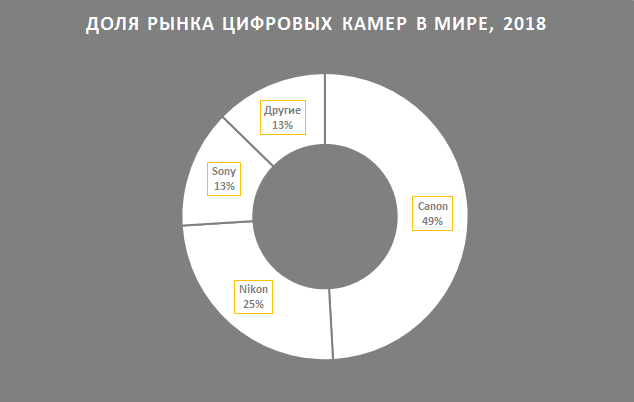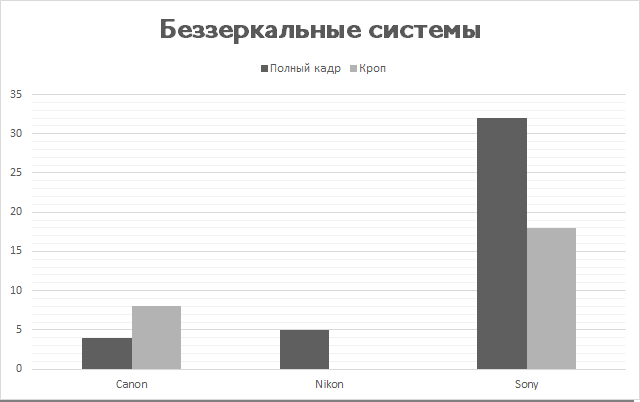What to choose? Just a few years ago this question bothered the majority of users and perhaps, was relevant. Today, if you look into search query stats, the most popular ones would be as follows: «Canon or Sony?» — 21 million results v.s. 9,4 million for the previous beaten question.
Unless we dot the i’s and cross the t’s, then we’d definitely try to pin down as much food for thought as possible so that you could make a conscious choice of camera for all your needs.
In the years when the first two DSLR camera manufacturers almost undividedly dominated the market, it was wise to purchase equipment from any of them, if you wanted to ensure high quality of images, have a wide range of accessories and a long after-sales service. Purchasing experimental equipment from other brands was somewhat risky due to a high chance of withdrawing it from production because of low popularity. As a result, a user runs a risk to be left without available spare parts, service centers, opportunities to update equipment and to sell a camera profitably.
Despite the global leadership of Canon and Nikon, both of them failed to «notice» the emerging market of mirrorless cameras, in which another Japanese company Sony have been investing already for many years. After having left a series of rather unpopular cameras, Sony managed to find a key to the audience. The quantity and quality of their innovations has led the company to the forefront not only in the production of mirrorless systems, but also of image sensors for the majority of digital cameras in the market, including Nikon. Now, the previous grandees in a new market segment are catching up.
In general, there is a number of noticable mass-market camera manufacturers — Canon, Nikon, Sony, Fuji, Olympus, Panasonic, Ricoh (Pentax), but the first three account for a big chunk of 87% of the market.

The dictate of reason suggests that it is safer to invest in technology that has good market prospects for the coming years. The grounds were already outlined. Although you should not discount other companies that are trying to catch up with the leaders and may offer revolutionary solutions. So, follow up novelties in any case.
Another decision-making factor may be the range of lenses available for your future camera.

At the DSLR market, Canon and Nikon are still tall in the saddle. Over their long history, they have released a wide variety of lenses for all occasions, for work in any genres and techniques. Nikon not only leads in the number of lenses for both full frame and cropped cameras, but also enables a user to put both types of lenses on any of its cameras, while Canon doesn’t allow installing lenses for APS-C format sensor on a full frame. The range of Sony lenses is much more modest, it lacks some special models and not for all focal lengths there is a choice of lens speed.

In the mirrorless market, the opposite is true. Sony is a leader that offers a variety of lenses. Nikon and Canon just entered the race for this segment and released their full-frame mirrorless cameras almost simultaneously in 2018. The optics range for them is predictably small, and if circumstances permit, they will need another 5-7 years to even out. However, thanks to the original adapters, lenses designed for SLR cameras are also suitable for mirrorless systems and work without limitations on either function or image quality.
If we consider third-party lenses, then there are 229 of them for full-frame Canon cameras of both systems, 224 for Nikon and 264 for Sony. The difference is not essential in case you are ok with using «third-party» manufacturers. Moreover, given the adapters from Canon to Nikon and all other possible combinations there is not much of a problem for an average user. Exceptions affect only special genres where specific lenses are required, for example, a Tilt-shift.
We did not dare to carry out a comprehensive analysis of the price range of lenses within this article, because that would be an enormous amount of work, but we selected several popular lenses that are present in all of the three major brands.
In general, Nikon stands out in this respect, because for almost all models it offers the best price. Canon goes along or is a little pricier. Sony lenses may be up to 30% more expensive in some cases.
Sometimes sympathy for the brand develops due to ergonomics or menu convenience. On the one hand, in practice we have seen that one can get used to anything, on the other hand, it’s nice when everything is suited and nothing distracts from the shooting process. This aspect can only be tested personally by visiting manufacturers’ promo events, renting a camera at a photo rental or borrowing from friends.
The last aspect to be considered in this article is the value of the video function. Market shares indicate that many consumers care for it. Both the significant growth in Sony’s popularity and the prevalence of Canon over Nikon can be attributed to better adaptation of their cameras for video recording tasks, which are gaining more and more popularity from year to year. Earlier, one could often hear an opinion that Nikon is the best camera for a photographer, and Canon is the best multimedia camera, albeit someone would always object it. In the last couple of years, Sony’s leadership in the field of shooting video on cameras has become indisputable due to their rich possibilities for recording video signals, high resolution at a large number of shots per second and an in-camera stabilizer.
In the coming years, Canon and Nikon will try to change the situation on the market of mirrorless systems, so it is most difficult to make forecasts in other segments.
Each of the three most popular companies will definitely continue to present new products, so choosing a camera from any of these three players will certainly be reasonable. In terms of functions these manufacturers are very close to each other, so in the end the choice is determined by the budget, a need to shoot video, a set of favorite genres and possible emotional attachment.
As for the other brands, I would like to further clarify my idea — Fuji, Olympus, Ricoh, Panasonic certainly produce good cameras and optics. However, their equipment is not so varied and universal, and their market share prompts a scenario, in which the companies may leave the market due to poor financial results or a radical change in market strategy and niche.
If you just started the journey, join Basic photography course at our school and consult with our teachers about a choice of camera.
Peter Pokrovsky.








